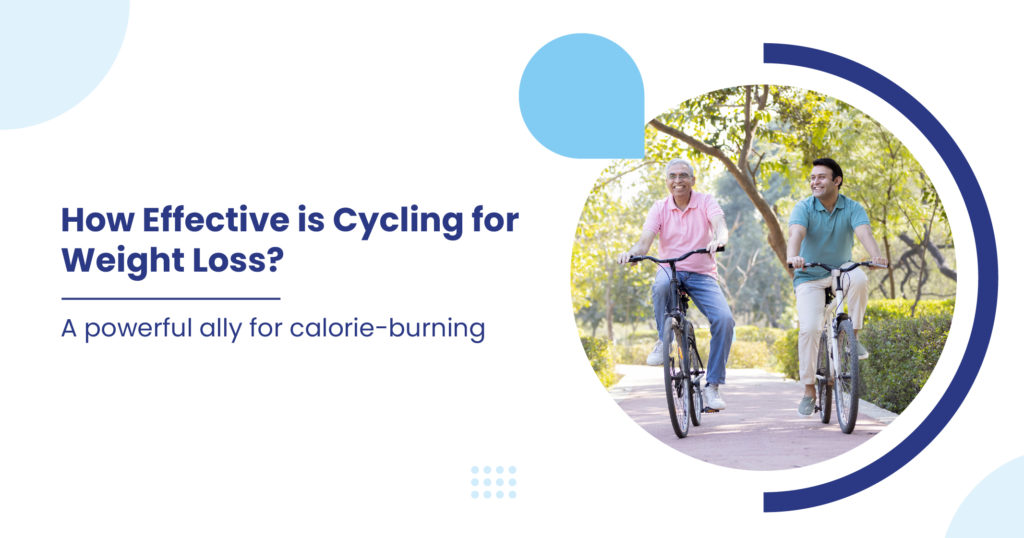Weight Loss & Cycling
Cycling provides a unique combination of calorie burning and metabolic enhancement, making it an efficient tool for weight loss. When you ride, your body taps into its stored fat and carbohydrates to supply the energy required for your workout.
As you increase the heart rate and challenge your muscles, your metabolism boosts, leading to continued calorie burning even after you finish cycling. This post-cycling metabolic surge, also called excess post-exercise oxygen consumption (EPOC), plays an important role in assisting you shed extra pounds over time.
Cycling does not just burn calories during your ride. It also helps build muscle. The inclusive engagement of your leg muscles while pedalling not only burns calories but also assists in attaining long-term weight loss goals.
By including cycling in your routine, you burn calories and make lasting changes to your metabolism and body composition. This is why cycling is the best choice for attaining and maintaining a healthier weight.
Cycling Tips For Effective Weight Loss
Begin Your Day With a Ride
One of the most efficient ways to jumpstart your weight loss journey is by going for a bike ride prior to breakfast. The idea behind the tip is to involve in fasting training, where your body taps into its stored fat for energy.
But, it is crucial not to starve yourself. If you prefer something in your stomach before your morning ride, try eating a light meal about an hour before.
Challenge Yourself
You can exhale lost fat through your lungs. This is why aerobic exercises, such as cycling, are ideal for burning fat. While there is a scientific explanation for this process, all you need to do is push yourself sufficiently to breathe heavily, which will assist in fat loss. To increase your fat burn, aim for 30 to 60 minutes at a moderate intensity.
Prioritize Lean Protein Consumption
An important principle to remember is to focus on consuming high-quality foods that are rich in lean protein while involved in physical activity. This approach will support your weight loss journey.
While protein-rich smoothies and juices may seem tempting and easy to make, it is equally important to include other protein sources like fish, chicken, pulses, tuna and tofu in your diet.
Furthermore, incorporate a variety of fresh fruits and vegetables, particularly those with a low glycemic index, to further increase your nutritional intake.
Take-Two Or Three High-Intensity Intervals Weekly
To attain optimal weight loss results, it is vital to incorporate high-intensity sessions into your fitness routine. These sessions have numerous benefits, such as increased post-exercise oxygen consumption, which can last up to 24- 36 hours after your workout.
Also, high-intensity training pushes your body to lower its temperature, metabolize lactate and replenish fuel stores, which contribute to an overall boost in metabolism.
You can replace two or three of your regular workout sessions with high-intensity interval training or combine them with a moderate ride.
Aim to cycle at seventy to ninety per cent of your maximum heart rate to transform your body into a calorie-burning machine. Nevertheless, it is vital to exercise caution and overexertion.
Track Your Progress and Remain Motivated
Don’t give up on cycling just after trying it for a few days. Remember that weight loss is a gradual process. Instead of feeling discouraged, keep an eye on your progress along the way.
At first, don’t entirely rely on the numbers shown on the scale. A regular scale won’t show that the extra pounds you see might result from gaining muscle through consistent cycling. Next, consider using a weight loss or body fat percentage measurement to monitor your progress.
What to Eat After a Long Ride?
After a lengthy cycling session, it is essential to provide your body with the nutrients it needs for recovery. Protein, hydration and carbohydrates are most important.
Protein helps repair muscle tissue, while carbohydrates assist in replenishing energy stores. Furthermore, consuming a few glasses of water is advised to replace lost fluids.
Here are a few excellent food options to consider after an intense ride:
Smoothies
Chicken
Eggs
Nuts and Nut Butter
Sweet Potato
Following cycling, it is important to replenish lost fluids as a top priority. Begin by consuming a whey protein smoothie, and ensure you drink enough water.
After rehydration, the next 30 minutes should be dedicated to consuming carbohydrates and protein-rich foods like seeds, nuts, and fruits. After showering and changing into fresh clothes, have a balanced meal consisting of complex carbohydrates and lean protein.
Conclusion
Cycling can be a valuable asset if your goal is weight loss or maintaining a hard-earned weight loss achievement.
FAQs
1. Can I lose belly fat by cycling?
Regular cycling has been proven to be beneficial in reducing belly fat, even though it requires patience and time. According to a recent study, including cycling in your routine can contribute to overall fat loss and support a healthy weight. To particularly target belly fat and decrease its circumference, engaging in moderate-intensity aerobic exercises like indoor or outdoor cycling has proven effective.
Facebook
Twitter
LinkedIn
WhatsApp
Email
DISCLAIMER: THIS BLOG/WEBSITE DOES NOT PROVIDE MEDICAL ADVICE
The Information including but not limited to text, graphics, images and other material contained on this blog are intended for education and awareness only. No material on this blog is intended to be a substitute for professional medical help including diagnosis or treatment. It is always advisable to consult medical professional before relying on the content. Neither the Author nor Star Health and Allied Insurance Co. Ltd accepts any responsibility for any potential risk to any visitor/reader.
